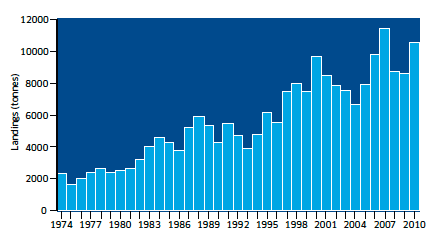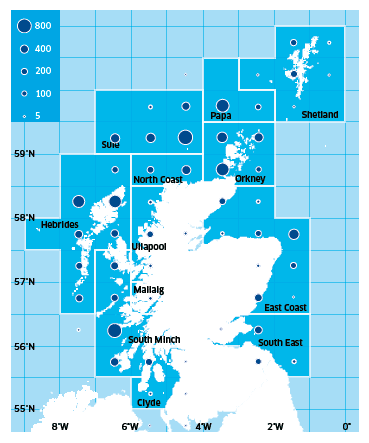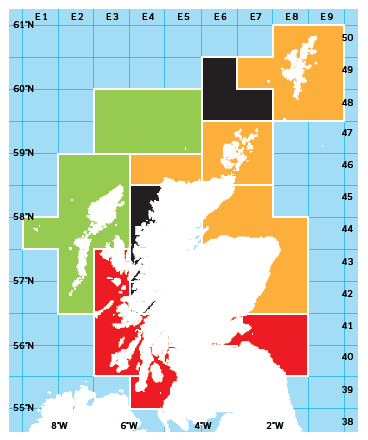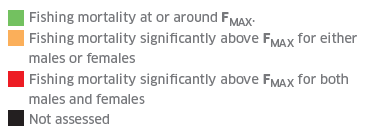Fish and Shellfish Stocks 2012
Fish and Shellfish Stocks 2012. State of Scottish fish stocks, TACs and biology of the stocks for 2012.
BROWN CRAB
Latin name :
Cancer pagurus
Common names : Edible crab, Brown
Introduction
The brown crab fishery is economically a very important fishery for Scotland with total landings in 2010 of around 10,600 tonnes and a value of £13.3 million. The fishery is long established and landings, although variable, have increased significantly over the last thirty years. Previously, most brown crab was caught inshore in mixed species creel fisheries. From the mid 1980s, technological advances allowed the fishery to expand to offshore areas to the west and north of Scotland, which nowadays account for almost a third of total landings. Landings from the five principal brown crab assessment units: the Hebrides, Sule, Papa, South Minch and Orkney, made up 72 % of the total in 2010. The majority of crabs are landed in the third and fourth quarters of the year and a large proportion are exported live to markets in southern Europe.
Biology and life cycle
The brown crab is found all around the Scottish coast from the shallow sub-littoral into offshore waters to depths exceeding 100 m. It inhabits rocky reefs, mixed coarse grounds and soft sediments (muddy sand) particularly on the offshore grounds. Brown crabs eat mainly benthic invertebrates, particularly bivalves, small decapods and barnacles; although their capture in baited traps indicates that they will also scavenge for food. In common with other crustaceans, brown crab grow by casting (moulting) their shell and then hardening a new larger shell. Growth rate varies between areas, and animals will typically reach minimum landing size, (140 mm carapace width CW) at four to six years old. Small animals may moult several times in a year, but at larger sizes growth slows down and the inter-moult period can be as long as four years. Female brown crabs in Scottish waters typically mature between 130-150 mm CW. During courtship the mature female is guarded by a male. Mating takes place post moult while the shell is still soft. Females produce up to three million eggs. Fertilised eggs are carried under the female's 'tail' for up to nine months, over the winter, until they hatch. The larvae are pelagic and drift with water movements until they settle to the seabed as miniature adults (about 2.5 mm in size) in summer or autumn depending on latitude and water temperature. Juvenile crabs are more commonly found in shallow inshore waters.
Adult crabs, especially females, can undertake extensive seasonal migrations (100s km), behaviour thought to be associated with reproduction. Migration of adults and the dispersal of larvae will both influence how connected stocks are. The structure of brown crab populations around Scotland is poorly understood.
Landings (tonnes) of brown crab into scotland by Scottish vessels, 1974 to 2010.

Management advice
The brown crab fishery is not subject to EU TAC regulations or national quotas although there are EU measures in place to restrict the fishing effort (kW days) of all vessels > 15 m (including creel boats) in ICES Subarea VI. In Scotland, vessels landing brown crabs are required to hold a licence with a shellfish entitlement. Vessels without this entitlement are only allowed to land limited amounts (25 crabs per day). The main regulatory mechanism is a minimum landing size of 140 mm CW to the north of 56°N and 130 mm CW to the south of 56°N (except for the Firth of Forth).
Assessment
Age determination is generally not possible for animals which moult and application of age-structured assessment methods to crustacean stocks is problematic. Length Cohort Analysis ( LCA) is the method used for assessing brown crab stocks. It uses official landings and length frequency data collected as part of the Marine Scotland Science market sampling programme. LCA results are calculated in terms of yield-per-recruit and biomass-per-recruit relative to changes in fishing mortality, providing a framework for evaluation of management measures. Assuming a direct relationship between fishing mortality and effort, generally, lower levels of fishing effort will result in an increase in stock size and a reduction in landings. A higher level of fishing effort will reduce total stock biomass but landings may also fall, as animals are caught before they have had time to grow to a size that would contribute much weight to the yield (growth overfishing). In between these lies F MAX the fishing mortality rate that maximizes yield per recruit. The changes that the LCA predicts are long term (equilibrium). The method does not provide any indication of short-term stock dynamics or recruitment over-fishing. Assessments are performed on a regional basis for males and females separately.
State of the stocks
Results of assessments based on LCAs for the period 2006-2008 for nine of the twelve assessment units, summarising estimates of fishing mortality in relation to the reference point F MAX are shown on the map. There were insufficient sampling data from the Mallaig, Ullapool and Papa areas to conduct LCAs. Of the assessed areas, the majority were growth overfished to some extent, particularly male crabs. In the areas of major importance for brown crab landings, fishing mortality was estimated to be significantly above F MAX for both males and females in Clyde, South Minch and South East whilst in the Hebrides and Sule, current fishing mortality was approximately F MAX . In Shetland, Orkney, North Coast and East Coast, the fishing mortality for females was close to F MAX while males were fished above F MAX . The stock assessment for brown crab in Scottish waters will be updated in 2012.
Creel fishery assessment areas and Scottish brown crab landings (tonnes) in 2010.

Management advice
Overall, assessments for the period 2006-2008 showed that most brown crab assessment units in Scotland were fished close to or above F MAX , which is above the optimum level to achieve the maximum yield per recruit. In many of the assessment units, a higher yield and biomass per recruit in the long term could potentially be obtained by reducing the level of fishing mortality (effort).
Creel fishery assessment areas and estimated fishing mortality, 2006 -2010.


Contact
There is a problem
Thanks for your feedback